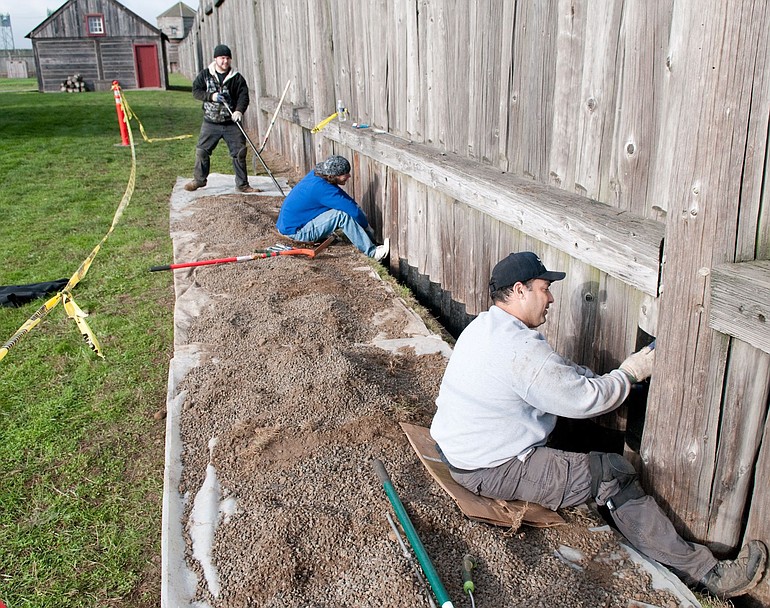The stockade at Fort Vancouver National Historic Site consists of 2,461 vertical Douglas fir and lodgepole pine logs.
The vertical logs forming the stockade are called pickets; the horizontal timbers are called walers.
Fort Vancouver
Stout logs formed a stockade 180 years ago to protect Hudson’s Bay Company officials, as well as their trade goods and fortune in fur.
But what protected the stockade?
Michael Carette-Meyers has been working on that — on the newest generation of log stockade at Fort Vancouver, anyway.
Carette-Meyers was overseeing a preventive-maintenance project this week to protect the Douglas fir and lodgepole pine logs from decay.
And in the process, he learned something else about security practices of the early settlers. They used locks.
Carette-Meyers knows that because a worker dug up a rusted iron lock while clearing dirt from the base of the stockade. A member of the National Park Service staff told him the artifact matched padlocks used here by the Hudson’s Bay Company more than 160 years ago, Carette-Meyers said.
Carette-Meyers is with Food Protection Services, a Tacoma-based company that doesn’t sound like the sort of business you’d employ to keep a fort on firm footing. But in addition to protecting grain and other agricultural products from vermin, the company treats log shipments to prevent invasive insects from hitching a ride.
The stockade project used a process called fumigation, said Alex Patterson, facilities supervisor at the Fort Vancouver National Historic Site. The fumigant is in a cartridge installed below ground level. A chemical is released that prevents fungus from decaying the wood.
“It hasn’t been done for 15 years, and it should be done on an eight-year cycle,” Patterson said. “If not, fungal decay will take over.”
The workers also wrapped the base of each log with a felt-like construction fabric.
Patterson said the project cost about $140,000.
“If we hadn’t spent this for prevention, we would have had a huge project ahead of us,” Patterson said.
The front of the replica stockade — the gated north wall — is Douglas fir, by the way. The other three walls are lodgepole pine.
“I think they used what was available in 1966 when the north wall went up,” Patterson said.
The north wall was the only wall for several years, but it was enough to present a fortlike facade for people passing by on Fifth Street.
“Lodgepole pine was the historically accurate wood,” Patterson said, and that’s what was used “in 1971 and 1972 when the other walls went up.”
While Carette-Meyers came to the job from the industrial side of things, he said he’s also excited about the heritage the site represents.
“I wanted to be part of the history,” Carette-Meyers said, since he could trace his own family back some transitional eras.
“My great-great-grandfather came from Indiana to Washington in a wagon,” he said. And when his great-great-grandmother headed for Washington, she was able to take the railroad.




